Gibb’s Reflection Cycle
VerifiedAdded on 2023/01/20
|7
|1523
|41
AI Summary
This part of Gibb’s reflection cycle will discuss the challenges faced during the clinical placement as a student nurse in the clinical setting.
Contribute Materials
Your contribution can guide someone’s learning journey. Share your
documents today.
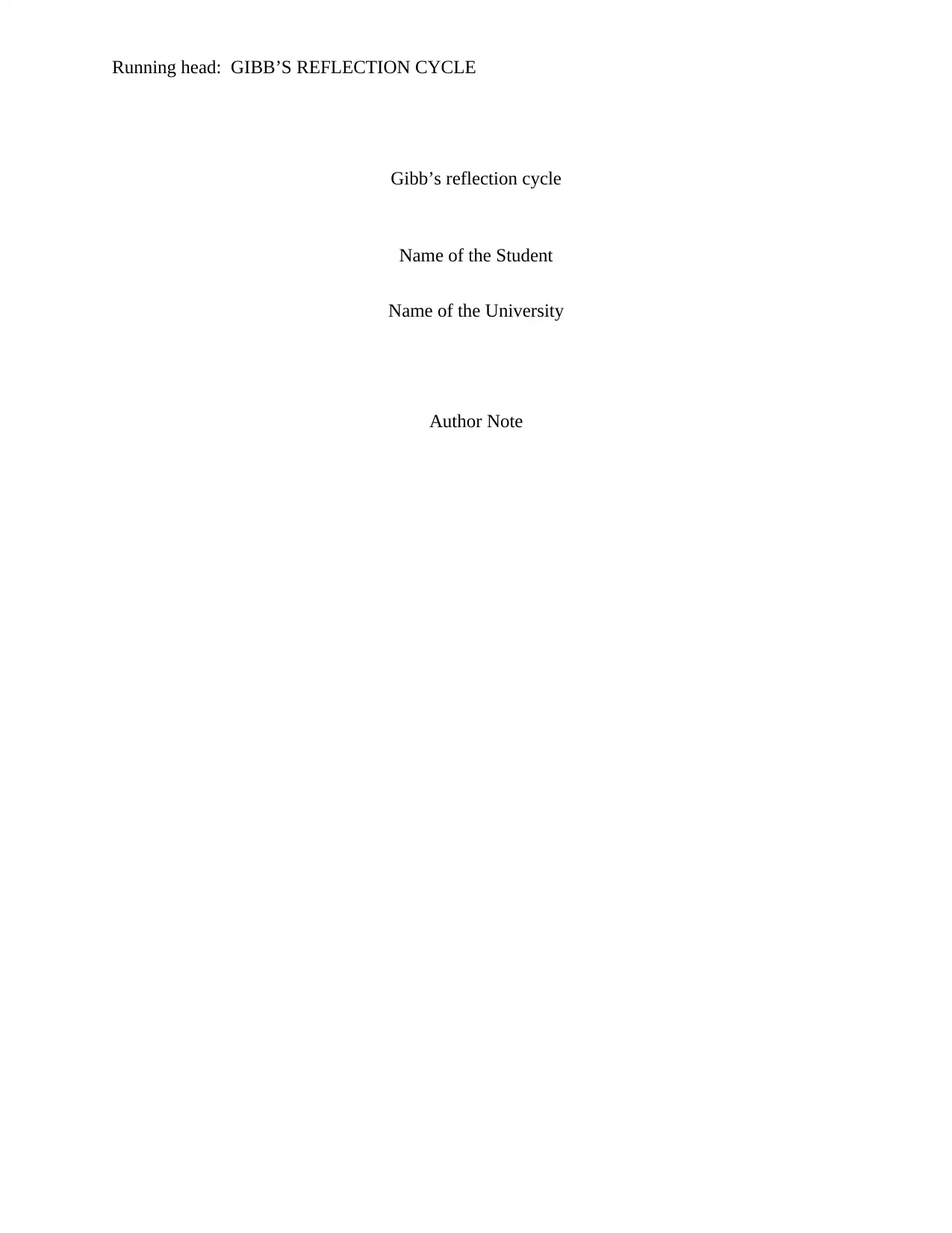
Running head: GIBB’S REFLECTION CYCLE
Gibb’s reflection cycle
Name of the Student
Name of the University
Author Note
Gibb’s reflection cycle
Name of the Student
Name of the University
Author Note
Secure Best Marks with AI Grader
Need help grading? Try our AI Grader for instant feedback on your assignments.
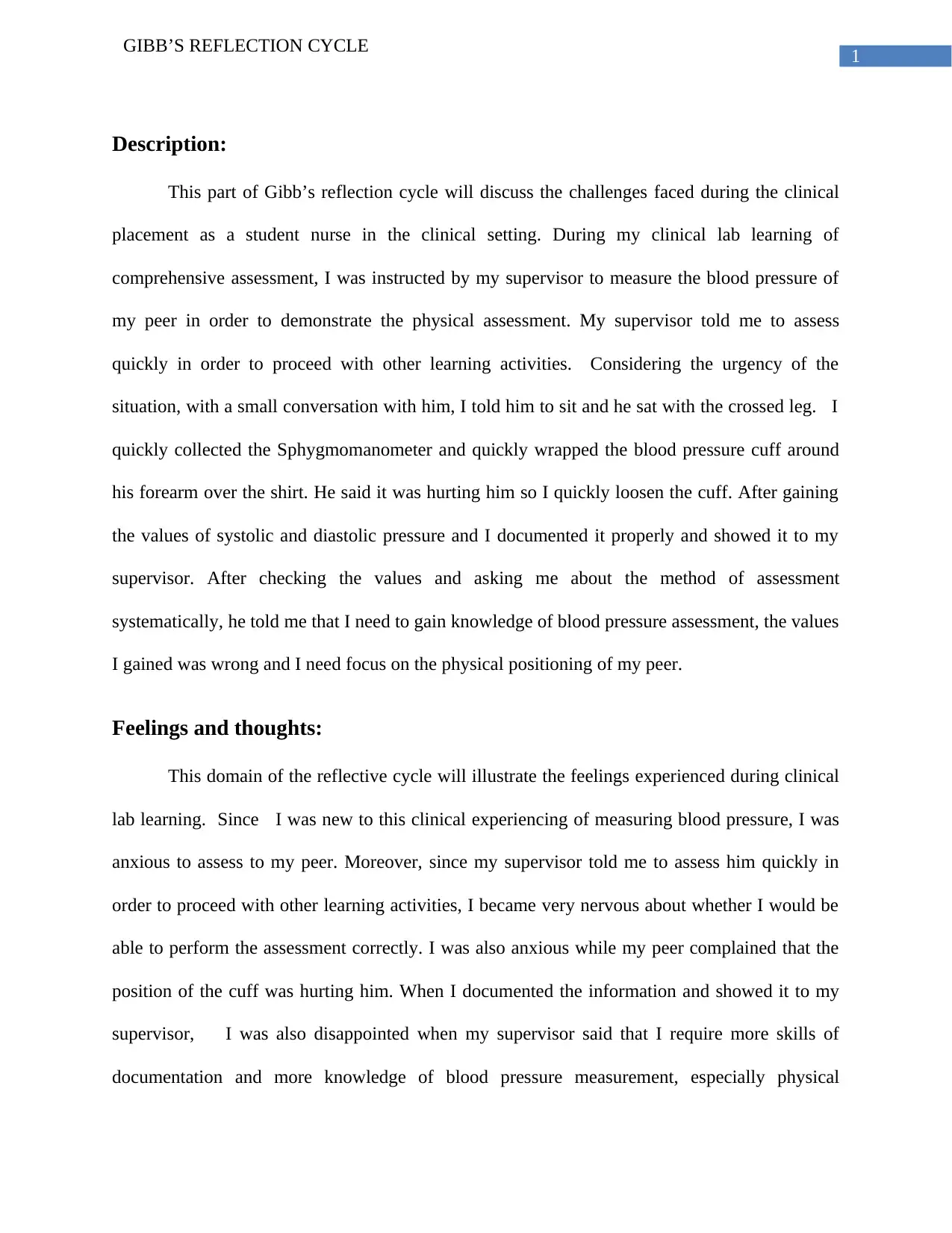
1
GIBB’S REFLECTION CYCLE
Description:
This part of Gibb’s reflection cycle will discuss the challenges faced during the clinical
placement as a student nurse in the clinical setting. During my clinical lab learning of
comprehensive assessment, I was instructed by my supervisor to measure the blood pressure of
my peer in order to demonstrate the physical assessment. My supervisor told me to assess
quickly in order to proceed with other learning activities. Considering the urgency of the
situation, with a small conversation with him, I told him to sit and he sat with the crossed leg. I
quickly collected the Sphygmomanometer and quickly wrapped the blood pressure cuff around
his forearm over the shirt. He said it was hurting him so I quickly loosen the cuff. After gaining
the values of systolic and diastolic pressure and I documented it properly and showed it to my
supervisor. After checking the values and asking me about the method of assessment
systematically, he told me that I need to gain knowledge of blood pressure assessment, the values
I gained was wrong and I need focus on the physical positioning of my peer.
Feelings and thoughts:
This domain of the reflective cycle will illustrate the feelings experienced during clinical
lab learning. Since I was new to this clinical experiencing of measuring blood pressure, I was
anxious to assess to my peer. Moreover, since my supervisor told me to assess him quickly in
order to proceed with other learning activities, I became very nervous about whether I would be
able to perform the assessment correctly. I was also anxious while my peer complained that the
position of the cuff was hurting him. When I documented the information and showed it to my
supervisor, I was also disappointed when my supervisor said that I require more skills of
documentation and more knowledge of blood pressure measurement, especially physical
GIBB’S REFLECTION CYCLE
Description:
This part of Gibb’s reflection cycle will discuss the challenges faced during the clinical
placement as a student nurse in the clinical setting. During my clinical lab learning of
comprehensive assessment, I was instructed by my supervisor to measure the blood pressure of
my peer in order to demonstrate the physical assessment. My supervisor told me to assess
quickly in order to proceed with other learning activities. Considering the urgency of the
situation, with a small conversation with him, I told him to sit and he sat with the crossed leg. I
quickly collected the Sphygmomanometer and quickly wrapped the blood pressure cuff around
his forearm over the shirt. He said it was hurting him so I quickly loosen the cuff. After gaining
the values of systolic and diastolic pressure and I documented it properly and showed it to my
supervisor. After checking the values and asking me about the method of assessment
systematically, he told me that I need to gain knowledge of blood pressure assessment, the values
I gained was wrong and I need focus on the physical positioning of my peer.
Feelings and thoughts:
This domain of the reflective cycle will illustrate the feelings experienced during clinical
lab learning. Since I was new to this clinical experiencing of measuring blood pressure, I was
anxious to assess to my peer. Moreover, since my supervisor told me to assess him quickly in
order to proceed with other learning activities, I became very nervous about whether I would be
able to perform the assessment correctly. I was also anxious while my peer complained that the
position of the cuff was hurting him. When I documented the information and showed it to my
supervisor, I was also disappointed when my supervisor said that I require more skills of
documentation and more knowledge of blood pressure measurement, especially physical
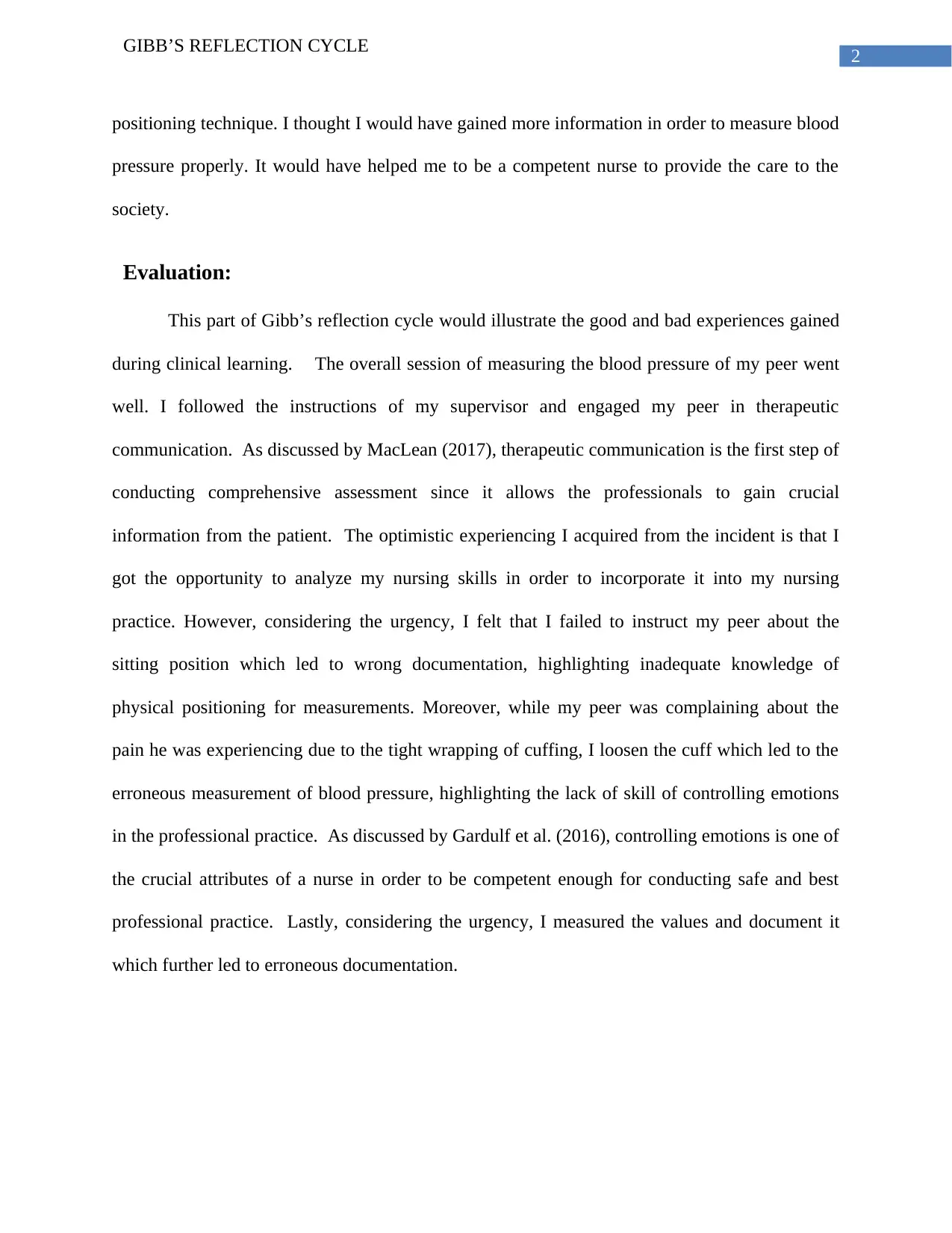
2
GIBB’S REFLECTION CYCLE
positioning technique. I thought I would have gained more information in order to measure blood
pressure properly. It would have helped me to be a competent nurse to provide the care to the
society.
Evaluation:
This part of Gibb’s reflection cycle would illustrate the good and bad experiences gained
during clinical learning. The overall session of measuring the blood pressure of my peer went
well. I followed the instructions of my supervisor and engaged my peer in therapeutic
communication. As discussed by MacLean (2017), therapeutic communication is the first step of
conducting comprehensive assessment since it allows the professionals to gain crucial
information from the patient. The optimistic experiencing I acquired from the incident is that I
got the opportunity to analyze my nursing skills in order to incorporate it into my nursing
practice. However, considering the urgency, I felt that I failed to instruct my peer about the
sitting position which led to wrong documentation, highlighting inadequate knowledge of
physical positioning for measurements. Moreover, while my peer was complaining about the
pain he was experiencing due to the tight wrapping of cuffing, I loosen the cuff which led to the
erroneous measurement of blood pressure, highlighting the lack of skill of controlling emotions
in the professional practice. As discussed by Gardulf et al. (2016), controlling emotions is one of
the crucial attributes of a nurse in order to be competent enough for conducting safe and best
professional practice. Lastly, considering the urgency, I measured the values and document it
which further led to erroneous documentation.
GIBB’S REFLECTION CYCLE
positioning technique. I thought I would have gained more information in order to measure blood
pressure properly. It would have helped me to be a competent nurse to provide the care to the
society.
Evaluation:
This part of Gibb’s reflection cycle would illustrate the good and bad experiences gained
during clinical learning. The overall session of measuring the blood pressure of my peer went
well. I followed the instructions of my supervisor and engaged my peer in therapeutic
communication. As discussed by MacLean (2017), therapeutic communication is the first step of
conducting comprehensive assessment since it allows the professionals to gain crucial
information from the patient. The optimistic experiencing I acquired from the incident is that I
got the opportunity to analyze my nursing skills in order to incorporate it into my nursing
practice. However, considering the urgency, I felt that I failed to instruct my peer about the
sitting position which led to wrong documentation, highlighting inadequate knowledge of
physical positioning for measurements. Moreover, while my peer was complaining about the
pain he was experiencing due to the tight wrapping of cuffing, I loosen the cuff which led to the
erroneous measurement of blood pressure, highlighting the lack of skill of controlling emotions
in the professional practice. As discussed by Gardulf et al. (2016), controlling emotions is one of
the crucial attributes of a nurse in order to be competent enough for conducting safe and best
professional practice. Lastly, considering the urgency, I measured the values and document it
which further led to erroneous documentation.
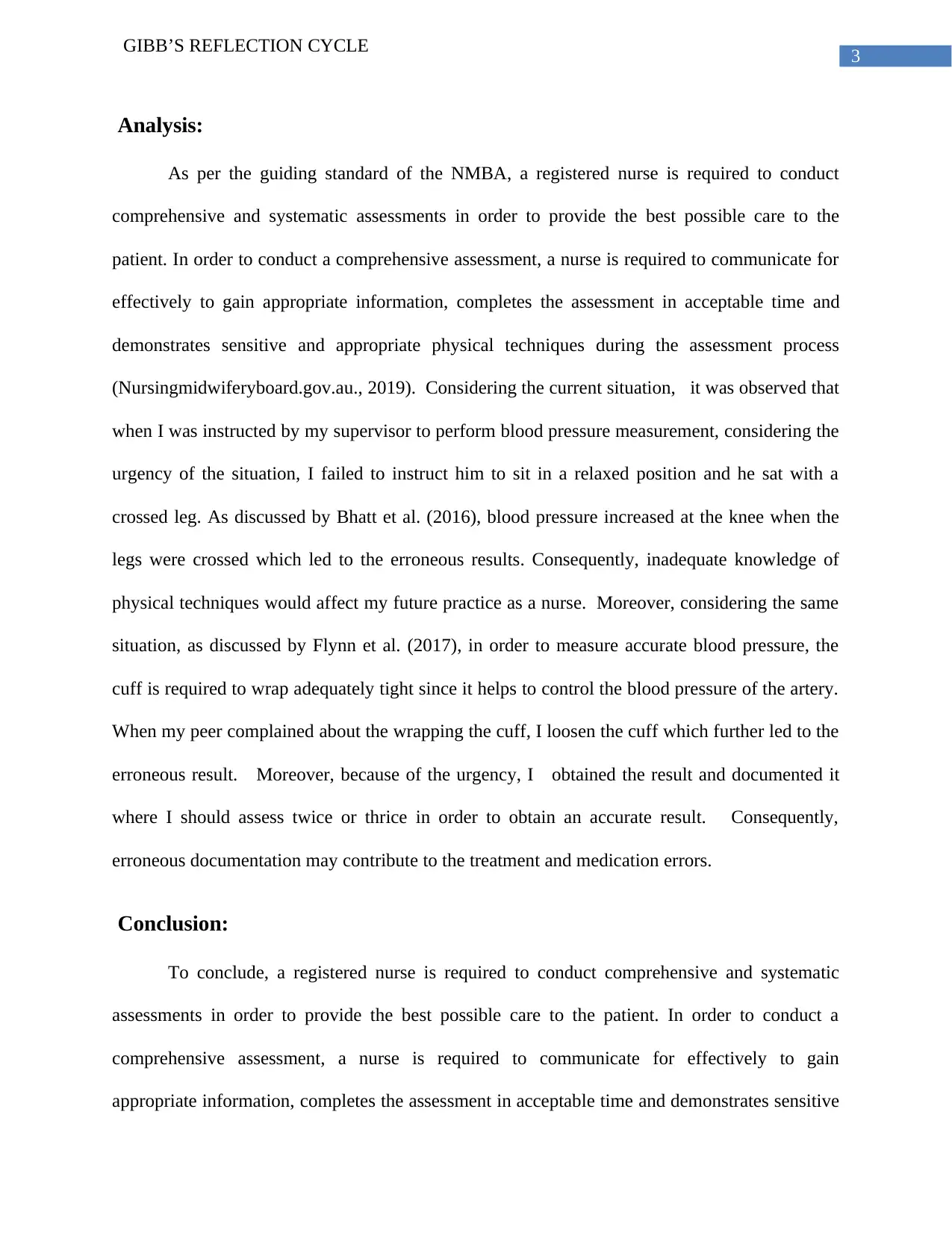
3
GIBB’S REFLECTION CYCLE
Analysis:
As per the guiding standard of the NMBA, a registered nurse is required to conduct
comprehensive and systematic assessments in order to provide the best possible care to the
patient. In order to conduct a comprehensive assessment, a nurse is required to communicate for
effectively to gain appropriate information, completes the assessment in acceptable time and
demonstrates sensitive and appropriate physical techniques during the assessment process
(Nursingmidwiferyboard.gov.au., 2019). Considering the current situation, it was observed that
when I was instructed by my supervisor to perform blood pressure measurement, considering the
urgency of the situation, I failed to instruct him to sit in a relaxed position and he sat with a
crossed leg. As discussed by Bhatt et al. (2016), blood pressure increased at the knee when the
legs were crossed which led to the erroneous results. Consequently, inadequate knowledge of
physical techniques would affect my future practice as a nurse. Moreover, considering the same
situation, as discussed by Flynn et al. (2017), in order to measure accurate blood pressure, the
cuff is required to wrap adequately tight since it helps to control the blood pressure of the artery.
When my peer complained about the wrapping the cuff, I loosen the cuff which further led to the
erroneous result. Moreover, because of the urgency, I obtained the result and documented it
where I should assess twice or thrice in order to obtain an accurate result. Consequently,
erroneous documentation may contribute to the treatment and medication errors.
Conclusion:
To conclude, a registered nurse is required to conduct comprehensive and systematic
assessments in order to provide the best possible care to the patient. In order to conduct a
comprehensive assessment, a nurse is required to communicate for effectively to gain
appropriate information, completes the assessment in acceptable time and demonstrates sensitive
GIBB’S REFLECTION CYCLE
Analysis:
As per the guiding standard of the NMBA, a registered nurse is required to conduct
comprehensive and systematic assessments in order to provide the best possible care to the
patient. In order to conduct a comprehensive assessment, a nurse is required to communicate for
effectively to gain appropriate information, completes the assessment in acceptable time and
demonstrates sensitive and appropriate physical techniques during the assessment process
(Nursingmidwiferyboard.gov.au., 2019). Considering the current situation, it was observed that
when I was instructed by my supervisor to perform blood pressure measurement, considering the
urgency of the situation, I failed to instruct him to sit in a relaxed position and he sat with a
crossed leg. As discussed by Bhatt et al. (2016), blood pressure increased at the knee when the
legs were crossed which led to the erroneous results. Consequently, inadequate knowledge of
physical techniques would affect my future practice as a nurse. Moreover, considering the same
situation, as discussed by Flynn et al. (2017), in order to measure accurate blood pressure, the
cuff is required to wrap adequately tight since it helps to control the blood pressure of the artery.
When my peer complained about the wrapping the cuff, I loosen the cuff which further led to the
erroneous result. Moreover, because of the urgency, I obtained the result and documented it
where I should assess twice or thrice in order to obtain an accurate result. Consequently,
erroneous documentation may contribute to the treatment and medication errors.
Conclusion:
To conclude, a registered nurse is required to conduct comprehensive and systematic
assessments in order to provide the best possible care to the patient. In order to conduct a
comprehensive assessment, a nurse is required to communicate for effectively to gain
appropriate information, completes the assessment in acceptable time and demonstrates sensitive
Secure Best Marks with AI Grader
Need help grading? Try our AI Grader for instant feedback on your assignments.

4
GIBB’S REFLECTION CYCLE
and appropriate physical techniques during the assessment process. Taking an insight into the
situation, I have inadequate knowledge of physical positioning for accurate blood pressure.
The incident highlighted that I also lack the skills of self-control. A nurse should have self-
control skills in order to provide accurate care to the patient. Furthermore, the incident
highlighted the lack of time management skills in an emergency situation which led to the
erroneous documentation.
Action plan:
Considering the current situation, the action plan is to gain an in-depth understanding of
accurate physical positioning during blood pressure measurements (Forbes & Watt, 2015). It
would be required to engage in the training of comprehensive assessment in order to apply the
evidence gained through detailed research (Sprangers, Dijkstra & Romijn-Luijten, 2015). It
would improve the clinical assessment and improve my documentation. I would require to
enroll my in meditation sessions in order to control emotion and manage the anxiety. I would
require to involve myself in the clinical workshops to improve my clinical documentation, blood
procurements, and time management.
GIBB’S REFLECTION CYCLE
and appropriate physical techniques during the assessment process. Taking an insight into the
situation, I have inadequate knowledge of physical positioning for accurate blood pressure.
The incident highlighted that I also lack the skills of self-control. A nurse should have self-
control skills in order to provide accurate care to the patient. Furthermore, the incident
highlighted the lack of time management skills in an emergency situation which led to the
erroneous documentation.
Action plan:
Considering the current situation, the action plan is to gain an in-depth understanding of
accurate physical positioning during blood pressure measurements (Forbes & Watt, 2015). It
would be required to engage in the training of comprehensive assessment in order to apply the
evidence gained through detailed research (Sprangers, Dijkstra & Romijn-Luijten, 2015). It
would improve the clinical assessment and improve my documentation. I would require to
enroll my in meditation sessions in order to control emotion and manage the anxiety. I would
require to involve myself in the clinical workshops to improve my clinical documentation, blood
procurements, and time management.
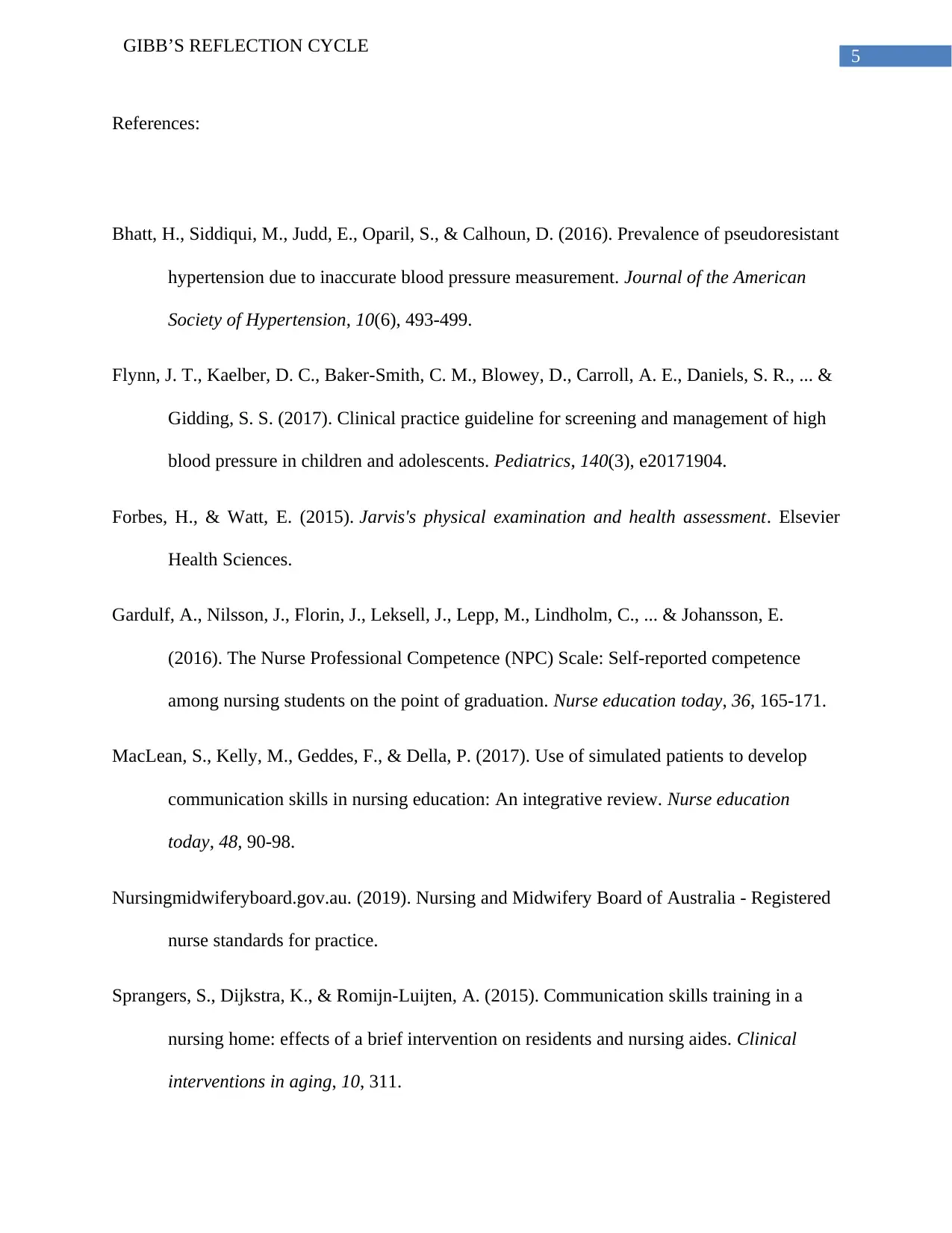
5
GIBB’S REFLECTION CYCLE
References:
Bhatt, H., Siddiqui, M., Judd, E., Oparil, S., & Calhoun, D. (2016). Prevalence of pseudoresistant
hypertension due to inaccurate blood pressure measurement. Journal of the American
Society of Hypertension, 10(6), 493-499.
Flynn, J. T., Kaelber, D. C., Baker-Smith, C. M., Blowey, D., Carroll, A. E., Daniels, S. R., ... &
Gidding, S. S. (2017). Clinical practice guideline for screening and management of high
blood pressure in children and adolescents. Pediatrics, 140(3), e20171904.
Forbes, H., & Watt, E. (2015). Jarvis's physical examination and health assessment. Elsevier
Health Sciences.
Gardulf, A., Nilsson, J., Florin, J., Leksell, J., Lepp, M., Lindholm, C., ... & Johansson, E.
(2016). The Nurse Professional Competence (NPC) Scale: Self-reported competence
among nursing students on the point of graduation. Nurse education today, 36, 165-171.
MacLean, S., Kelly, M., Geddes, F., & Della, P. (2017). Use of simulated patients to develop
communication skills in nursing education: An integrative review. Nurse education
today, 48, 90-98.
Nursingmidwiferyboard.gov.au. (2019). Nursing and Midwifery Board of Australia - Registered
nurse standards for practice.
Sprangers, S., Dijkstra, K., & Romijn-Luijten, A. (2015). Communication skills training in a
nursing home: effects of a brief intervention on residents and nursing aides. Clinical
interventions in aging, 10, 311.
GIBB’S REFLECTION CYCLE
References:
Bhatt, H., Siddiqui, M., Judd, E., Oparil, S., & Calhoun, D. (2016). Prevalence of pseudoresistant
hypertension due to inaccurate blood pressure measurement. Journal of the American
Society of Hypertension, 10(6), 493-499.
Flynn, J. T., Kaelber, D. C., Baker-Smith, C. M., Blowey, D., Carroll, A. E., Daniels, S. R., ... &
Gidding, S. S. (2017). Clinical practice guideline for screening and management of high
blood pressure in children and adolescents. Pediatrics, 140(3), e20171904.
Forbes, H., & Watt, E. (2015). Jarvis's physical examination and health assessment. Elsevier
Health Sciences.
Gardulf, A., Nilsson, J., Florin, J., Leksell, J., Lepp, M., Lindholm, C., ... & Johansson, E.
(2016). The Nurse Professional Competence (NPC) Scale: Self-reported competence
among nursing students on the point of graduation. Nurse education today, 36, 165-171.
MacLean, S., Kelly, M., Geddes, F., & Della, P. (2017). Use of simulated patients to develop
communication skills in nursing education: An integrative review. Nurse education
today, 48, 90-98.
Nursingmidwiferyboard.gov.au. (2019). Nursing and Midwifery Board of Australia - Registered
nurse standards for practice.
Sprangers, S., Dijkstra, K., & Romijn-Luijten, A. (2015). Communication skills training in a
nursing home: effects of a brief intervention on residents and nursing aides. Clinical
interventions in aging, 10, 311.
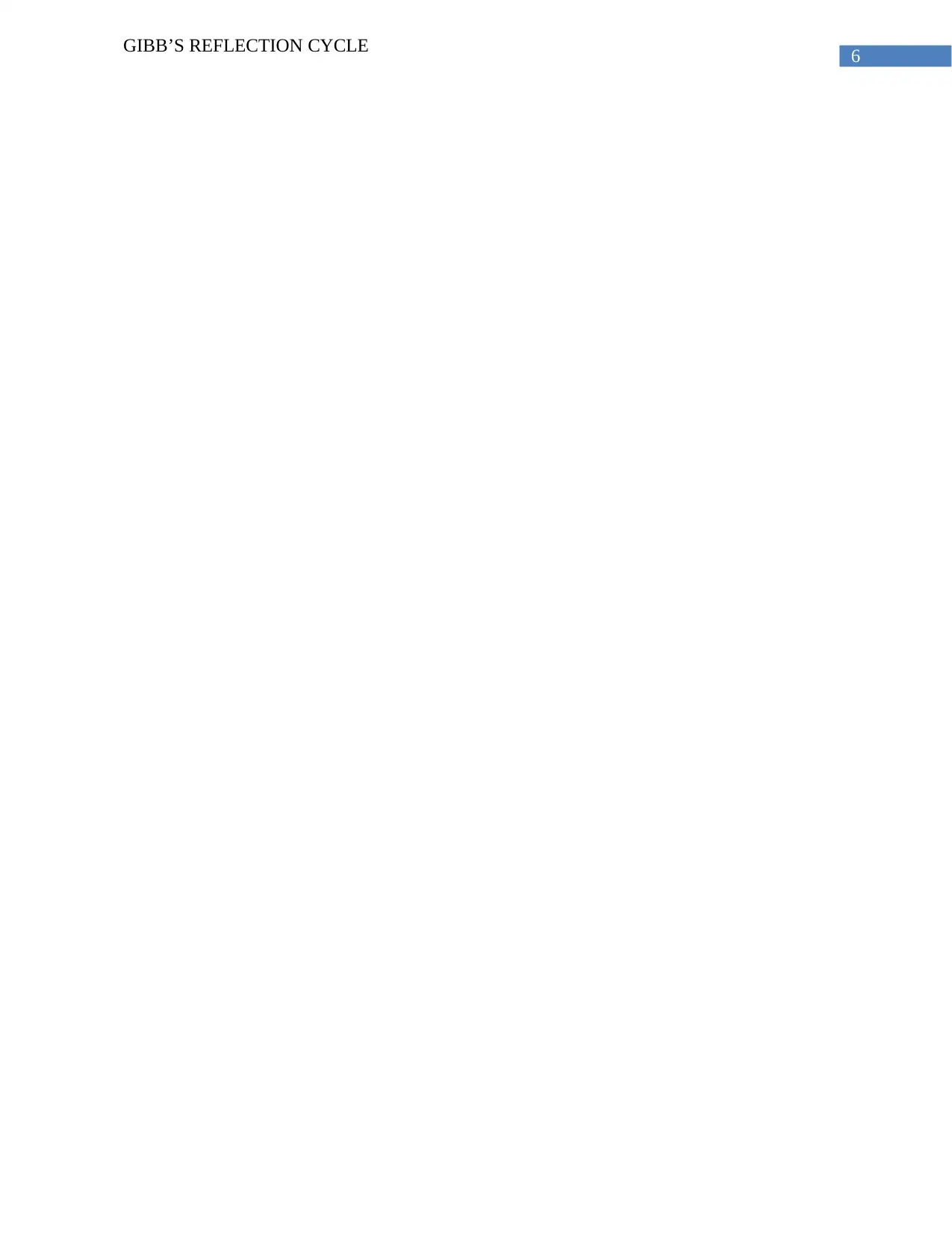
6
GIBB’S REFLECTION CYCLE
GIBB’S REFLECTION CYCLE
1 out of 7
Related Documents
Your All-in-One AI-Powered Toolkit for Academic Success.
+13062052269
info@desklib.com
Available 24*7 on WhatsApp / Email
![[object Object]](/_next/static/media/star-bottom.7253800d.svg)
Unlock your academic potential
© 2024 | Zucol Services PVT LTD | All rights reserved.





